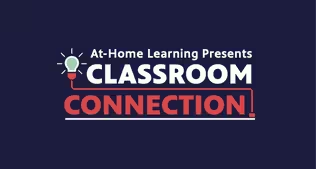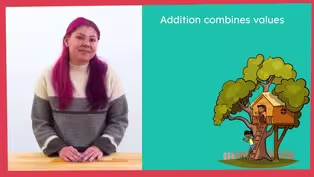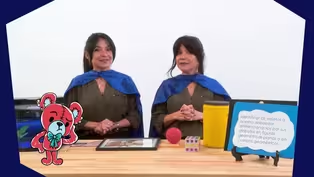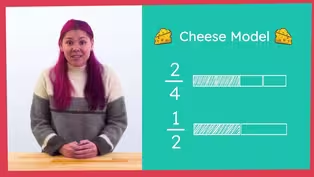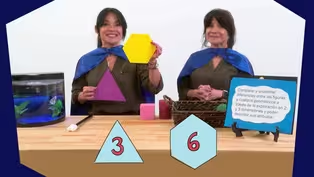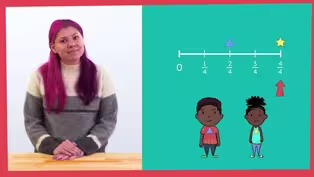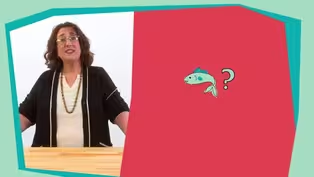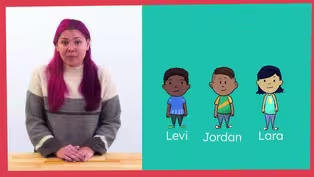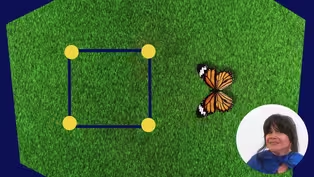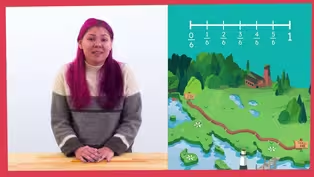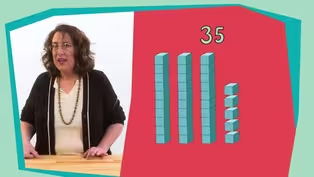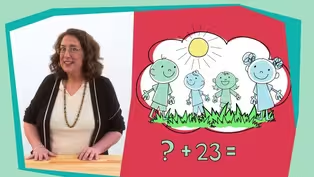
Episode 14 | Math Lessons
3/15/2021 | 28m 46sVideo has Closed Captions
Math lessons for early learners, led by NC teachers.
The first lesson (aimed at 3rd graders) helps students develop conceptual understanding of division. The second lesson (aimed at 1st-2nd graders) helps learners understand the relationship between addition and subtraction. Classroom Connection is your At-Home Learning companion where children love to learn. All lessons are led by NC educators.
Problems playing video? | Closed Captioning Feedback
Problems playing video? | Closed Captioning Feedback
At-Home Learning Presents: Classroom Connection is a local public television program presented by PBS NC

Episode 14 | Math Lessons
3/15/2021 | 28m 46sVideo has Closed Captions
The first lesson (aimed at 3rd graders) helps students develop conceptual understanding of division. The second lesson (aimed at 1st-2nd graders) helps learners understand the relationship between addition and subtraction. Classroom Connection is your At-Home Learning companion where children love to learn. All lessons are led by NC educators.
Problems playing video? | Closed Captioning Feedback
How to Watch At-Home Learning Presents: Classroom Connection
At-Home Learning Presents: Classroom Connection is available to stream on pbs.org and the free PBS App, available on iPhone, Apple TV, Android TV, Android smartphones, Amazon Fire TV, Amazon Fire Tablet, Roku, Samsung Smart TV, and Vizio.
Providing Support for PBS.org
Learn Moreabout PBS online sponsorshipMore from This Collection
Math lessons for early learners, led by NC teachers.
Video has Closed Captions
Math lessons for early learners, led by NC teachers. (28m 46s)
Video has Closed Captions
Math lessons for early learners, led by NC teachers. (28m 46s)
Video has Closed Captions
Math lessons for early learners, led by NC teachers. (28m 46s)
Video has Closed Captions
Math lessons for early learners, led by NC teachers. (28m 46s)
Video has Closed Captions
Math lessons for early learners, led by NC teachers. (28m 46s)
Video has Closed Captions
Math lessons for early learners, led by NC teachers. (28m 46s)
Video has Closed Captions
Math lessons for early learners, led by NC teachers. (28m 46s)
Video has Closed Captions
Math lessons for early learners, led by NC teachers. (28m 46s)
Video has Closed Captions
Math lessons for early learners, led by NC teachers. (28m 45s)
Video has Closed Captions
Math lessons for early learners, led by NC teachers. (28m 46s)
Video has Closed Captions
Math lessons for early learners, led by NC teachers. (28m 45s)
Video has Closed Captions
Math lessons for early learners, led by NC teachers. (28m 46s)
Providing Support for PBS.org
Learn Moreabout PBS online sponsorship[cheerful upbeat music] ♪ - Wow, did you know there are 86,400 seconds in a day?
How do we know this?
Math.
Thanks for spending 1,800 of them with us.
Here's today's math lesson.
- Hello friends, Diane here.
Today we're going to be talking about strategies for solving multiplication and division problems.
Before we get started, let's review what we know about equal groups.
Let's use a frayer model to help us out, are you ready?
Let's get started.
To make our frayer model you will need a piece of paper and a pen, a pencil, or a marker.
I'm going to get my supplies, you go ahead and do the same.
[upbeat music] Now that we have our supplies, let's begin making our frayer model.
Let's take a piece of paper and fold it in half hamburger style.
Then, we'll fold it in half again to make four equally sized rectangles.
Then, in the corner where all the sides are folded together we're gonna fold down to make a small triangle.
Now, when you unfold the paper the folds should look like this.
Does yours look like mine?
Okay great.
We're going to write the word equal groups in the center diamond, because this is the word we need to understand more about.
[pen scribbling] Then in the upper left rectangle, we're going to define this term.
So let's write the word definition here.
In the upper right triangle or rectangle, woopsie daisies, we're going to provide an example of equal groups.
So let's write example here, then in the lower left rectangle we'll provide a non-example or what equal groups are not.
So write non-example here.
And finally in the lower right rectangle, we'll draw a picture to help us visualize what equal groups are.
So let's write the word picture here to remind us of what we're supposed to do.
Now we're going to define equal groups together.
So let's write that definition in our upper left rectangle.
A group is an equal group if it has the same number of items as all the other groups.
We can use equal groups to help us think about multiplication and division problems.
I'm going to give you some time to write this definition in your frayer model.
[upbeat music] As we learn more about equal groups in today's lesson you will be able to add examples, non-examples and draw a picture to share your growing understanding of equal groups.
Let's place our frayer model to the side and take a look around.
Can you guess where I am, right.
The zoo.
The zoo has a contest going on today to see who can complete the scavenger hunt first.
I have to find certain animals and record how many I see, wanna see how I'm doing?
I have three giraffes, two hippos, five lions, four penguins and 10 flamingos.
I'm so close to being finished.
I just have to go to the elephant exhibit and count the number of elephants.
Oh no!
The elephant exhibit is closed.
How will I finish the scavenger hunt?
[elephant trumpets] Wait a minute.
I see feet, elephant feet.
I see 20 elephant feet.
I found all of the animals but I don't know how many elephants there are.
What am I going to do?
How can I find out?
I really want to win this scavenger hunt.
Can you help me?
What is that?
You'll help me solve this problem.
Oh my gosh, thank you so much.
Let's see if there's anything I know about the other animals on my list and the number of feet they have to help me solve this problem.
Let's take a few moments to do some thinking on our own.
[upbeat music] Did you come up with any ideas?
Those are some great ones.
So let's start with giraffes.
What can you tell me about the number of giraffe feet?
Right, I have three giraffes and each giraffe has four feet.
That's three groups of four.
So three times four equals 12 feet.
The number of feet is represented by the total or the product.
Let's try another one.
What could you tell me about the number of penguin feet?
Right.
I have four penguins and each penguin has two feet.
What would our multiplication equation be to represent the total number of penguin feet?
Fantastic.
Four times two.
Four is the number of penguins, two represents the number of feet on each penguin and eight is the total number of feet.
Okay.
Can you help me represent what we know about the elephants?
I know that there are 20 feet altogether, so I'll put 20 after the equal sign to show the total number of feet.
Then I know that elephants have four legs, so four feet.
I'll put the four in the second blank to show how many feet are on each elephant.
Blank times four equals 20.
I'm looking for the number of elephants or another way to say that is the number of groups.
I can represent this type of problem with a multiplication equation or a division equation since multiplication and division are related.
What ideas do you have for solving this problem?
I'll give you a few moments to try and solve on your own.
[guitar music] How did you solve it?
What's that?
That's a great idea.
We can draw dots in groups of four to represent the elephant feet until we get a total of 20 dots, or elephant feet.
So one, two, three, four, five, six, seven, eight, nine 10, 11, 12, 13, 14, 15, 16, 17, 18, 19, 20.
How many groups of four or elephants do we have?
Exactly, five.
Did anyone else solve it a different way?
Oh, you kept subtracting four from 20 until you reach zero.
Let's see what that looks like.
Interesting.
I see where the total number of feet are represented, the 20.
And I see that you are subtracting four each time the number of feet on each elephant.
So where do you see the number of elephants?
Oh, the number of times you subtracted four represents the number of elephants.
Well we subtracted five times, so there are five groups of four in the number 20.
There are five elephants.
Awesome.
I can check off my last animal from the scavenger hunt.
Oh, look at this.
There's a bonus question.
I'll win for sure, if I complete that.
Let's see what it says.
Oh, a riddle.
Whew, right.
With 80 legs, we spin our home.
On webs we like to crawl and roam.
We're not the favorite to see, but helpful, smart, and most friendly.
Can we solve this?
Great.
This seems like the same kind of problem as the elephant feet.
We know there are 80 total legs but it doesn't tell us what kind of animal it is.
But there are clues.
What animal is this?
Right.
A spider.
It spins webs and crawls.
And all spiders have eight legs.
So what equation could we use to represent this?
Yeah, for sure.
What times eight equals 80 or 80 divided by eight equals what?
We know the total number of legs and the number of each group.
We are looking for the number of groups or spiders in this case.
So let's solve.
I'll give you a few moments to try it on your own.
[upbeat music] What did you get?
Did you say 10?
How did you solve it?
So some of you put the 80 legs into groups of eight.
Well and it might look like this.
And others used your multiplication facts.
10 times eight equals 80.
And others have subtracted groups of eight from 80.
Those are all great strategies and helped us find the number of spiders, 10.
Boom.
Thanks for helping me solve the problem of unknown number of elephants and the bonus question.
You reminded me that we can represent an unknown number of groups, problems with multiplication and division.
You also showed me that we can solve an unknown number of groups problems with multiplication facts, counting or subtraction strategies.
Great job today.
I'm going to turn in my scavenger hunt now.
Wish me luck.
See you next time.
- That was awesome.
Right, If you like animals and nature, you'll love this one.
What did the Buffalo say when it's son went to college?
Bye son.
Get it?
Bison, by sun.
All right , okay, okay, okay.
I admit a little cheesy.
But speaking of cheese, did you know most cheese come from cows?
But there are plenty other sources like goats or sheep.
They're even vegan options from different kinds of nuts.
You learn something new each day, am I right?
- Hi everybody!
We're at the North Carolina zoo and in particular today, I'm here to look at their diets.
Take a second and think about this.
We all probably spend a lot of time thinking about what we put in our body.
Well, at the North Carolina Zoo they do the same thing for their animals.
So I went around the zoo to figure out what they're doing with the animal diets.
- There's a lot that goes on behind the scenes with the food [upbeat music] We've got a team of five food prep assistants here of rain, sleet, snow holiday, you name it.
They're here preparing diets and delivering them around the park.
- [Woman] What do they love to eat?
- Fish - [Katie] Everything from fish to rodents, chickens, rabbits, to blood.
- It's blood.
- For?
- A vampire bird.
- No.
- Yeah.
- Whoa, oh my goodness - [Camera man] Looks lovely, doesn't it?
- That, it does.
- Gut loaded mealworms.
- [Camera Man] We're going to see the gut loading of mealworms.
[laughter] - [Camera Man] Oh yeah.
I don't even know what that means.
Gut loading, but... - Gut loading.
It sounds like a very invasive process but it's not specifically formulated diet to impart a certain nutritional value, the mealworm, the cricket, the super worm, the wax worm.
It's just a way for us to know that our animals are getting the nutrition they need.
It's a lot of animals need that live food in order to have a good feed response and good feed reaction.
- Every bucket has a name on it that represents one of the animals in the exhibit.
Picture this as like a class of school kids like with special diets.
That's essentially what this is.
Every single animal in here has a special diet to be able to feel good.
- [Katie] We try our best to think about what this animal would be eating in the wild and not only what they would be eating but how they would be feeding.
- [Camera Man] I see on this package, the gorilla, but in the wild they're just eating plants.
- Right, yeah.
And for us at this too, it's actually a little bit different because we don't give our gorillas chow.
So our gorillas are one of the only gorillas in the country that are on a chow-free diet.
Our gorillas are eating completely produced based diet.
So that means they have to get a lot of bulk, a lot of fiber.
- We're going into the special greenhouses now.
- [Narrator] This is a native African plant that will give them some of their fiber.
- We'll cut big pieces like this for gorilla.
- [Camera Man] And the gorillas eat it?
- The gorillas eat it.
- Yeah, we give it to gorilla and then we also give it to Chimp and to giraffe right now.
- [Narrator] This is all a great example of how the North Carolina zoo is applying the science of animal nutrition to the gorillas.
Based on the research of wild gorillas the zoo formulated a new diet designed to more closely mimic their diet.
This meant replacing the formulated biscuits they had previously been fed with large amounts of leafy green vegetables.
By carefully analyzing the nutritional content of the vegetables, the zoo was able to provide all the nutrients the gorillas need to thrive.
The new diet increased the activity of the gorillas and decreased the levels of inflammation in their digestive track that can potentially cause disease.
And the young gorillas at the North Carolina zoo are the only ones in the whole country that have spent their entire lives eating this new entirely plant-based diet.
In another area of the zoo they have what's called a browse garden.
This provides year round browse for the animals to eat fresh.
There are over five acres with seven main gardens and a scent garden.
This year alone they've had almost 500 trucks of browse cut for the animals.
- We don't wanna feed an animal from a bowl.
We want to make sure that we're providing a very diet, providing it in a way that an animal can naturally feed in a natural feeding response.
- [Narrator] This educational skunk stinker is a great example of that.
They're actually feeding her grubs today, but instead of putting them in a bowl, they're putting them in the dirt just like she would naturally feed.
- We're trying to recreate what would be their natural state, their natural life as much as possible.
And I know that we're a puzzle piece in that, that's what's the biggest driving factor for me.
- [Narrator] So the next time you were at the zoo I hope you have a better appreciation for the amount of work and thought that the keepers put into animal diets.
- I just learned that snails can take naps that are three years long.
[chuckles] Okay, that's more than a nap.
Can we agree?
If you slept for three years you miss like three birthdays.
That's like three pieces of cake.
Well keep those eyes open now or you might miss this next mad lesson.
- Hi friends.
My name is Dawn and I am so happy to be here with you today.
And I brought my friend along, Splat.
Before we get started, you might want to get a trusted adult or stuffed animal to talk about your math thinking.
You might want to get some beans or pasta to help you make the different numbers we see today.
Finally, you might want to get some paper and a pencil so you can write about your math learning at the end of our time together.
I'll wait while you get what you need.
Welcome back.
I hope you have all that you need.
We are going to have some fun with subitizing today.
Subitizing is quickly seeing how many items are present such as dots.
Splat wanted to join us today and learn about a really awesome tool we are going to use called a five frame.
This will help us organize our thinking when we see dots.
We're going to show you how, some dots in the five frames very quickly, your job is to say or show how many dots you see with each picture that flashes on our screen.
Then you get to explain out loud to an adult or stuffed animal how you see the dots.
Splat isn't really sure how this will all work.
So we are going to help him out.
Are you ready?
[cat meows] Let's go, watch the screen.
Oh, that was super quick.
Say out loud or make with your beans or pasta how many dots you saw.
Did you hear that Splat?
They saw seven.
That's right.
How did you see the seven dots?
Will you say that out loud?
So Splat can hear how your brain saw those dots or you can make the dots with the beans or pasta.
My brain saw four dots on top and three dots on bottom.
And I know that if I move one dot to the top, that makes five and that five plus two equals seven.
I wonder how many dots I need to make both five frames full.
Can you whisper to yourself or use your beans or pasta to show how many dots I'd have to add to make all of my squares full?
That's right.
I need three dots and both five frames would be full.
That would make a 10.
We know this because three plus seven equals 10.
You worked so hard on this.
Let's do another one.
Watch the screen.
That was super quick again.
Tell an adult or stuffed animal out loud.
So Splat can hear you, how many dots you saw on the screen.
You saw eight dots?
We did too.
Now tell Splat how you saw the dots or you can make the picture of dots with your beans or pasta.
My brain saw the two empty squares, and I know that two less than 10 is eight.
So I knew there were eight squares because 10 minus two equals eight.
Splat whispered to me that he saw four dots on top and four dots on bottom.
And he knows that four plus four equals eight because it's one of the doubles he's learned.
That's correct Splat.
What great math thinking you are doing today.
I think Splat is getting the hang of this.
I know you are doing lots of thinking about our five frames.
I have another question.
How many dots do we need to make both five frames full?
This would make 10.
Can you whisper to yourself how many dots you would add to make 10?
Two, that's right.
We need two dots to make 10 because two plus eight equals 10.
Wow, you and Splat worked so hard on making a 10 with our five frames.
I think you're ready for another one.
Watch the screen.
[upbeat music] You're doing such a great job of watching for our five frames.
Tell an adult or stuffed animal what you saw when our dots flashed up on the screen.
I bet you saw nine, just like Splat and I did.
How did you see nine?
Think about how the dots were organized so that you knew there were nine dots.
Tell an adult or stuffed animal what you saw so you would know there were nine dots.
You could also make the dots you saw with your beans or pasta.
Splat, look at these five frames.
The bottom one is missing a dot and I know that one less than 10 is nine.
So there must be nine dots.
Splat, can you help me think of another way to see the dots?
Splat says he saw five dots on top and four dots on bottom and he knows that five plus four equals nine.
Wow, that is some really great thinking.
Okay friends, you've done some really great subitizing today.
It's time for our last set of dots.
Are you and Splat ready?
Watch the screen.
Oh, did you see that?
How many dots were there?
That is good thinking.
There were 10 dots.
Tell a friend or stuffed animal what you saw with your brain and Splat is going to whisper to me how many dots there were and what his brain saw.
Splat and I saw 10 dots too.
And we saw two, five frames all filled up with five dots on the top and five dots on the bottom.
I know that five plus five equals 10.
So there must be 10 dots.
What else did you notice about our five frames?
Can you whisper to Splat what you see that looks different?
Yes, we have only one 10 frame instead of two five frames.
We have one whole 10.
It's like we traded in our ones for one whole 10.
Oh, that is super exciting.
Friends, it is almost time for Splat and me to go today.
I'm so glad we got to do some subitizing together.
And we got to teach Splat how five frames work and how to explain our thinking.
You really thought hard to figure out how many dots there were in the five and 10 frame.
You were also good at figuring out how many dots we needed to make 10.
But before we go Splat and I would love to hear you say what you learned today.
I have these sentence starters and I'm hoping you can finish these sentences with me.
They say today in math I learned and I can.
So I might say, today in math I learned how to subitize with numbers in five frames.
I can add parts of numbers together to make a whole.
Now it's your turn.
Read this with me and finish it by telling an adult or stuffed animal.
Today in math I learned... Now let's read our next sentence and you can finish it.
I can... You are doing a great job talking about your math learning.
Next, you could also write this on paper or in your notebook and start a math journal.
Splat and I must go now, but remember subitizing helped us see that our numbers are composed or made up of other numbers.
Recognizing and combining groups can help us name a total and different ways to make that total.
We are so proud of how hard you worked today.
Splat and I will see you soon.
- What a cool math lesson.
I cannot wait for the next lesson.
Practice makes perfect they say, but really I just like getting better one day at a time.
Each day is a new opportunity to learn and grow and I'm glad we got to do it together.
[cheerful upbeat music] ♪


- Home and How To

Hit the road in a classic car for a tour through Great Britain with two antiques experts.












Support for PBS provided by:
At-Home Learning Presents: Classroom Connection is a local public television program presented by PBS NC
